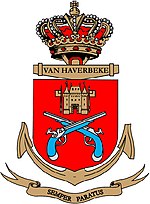HMS Ready (J223)
 A. F. Dufour (M902)
| |
| History | |
|---|---|
| Name | Ready |
| Namesake | Ready |
| Ordered | 15 November 1940 |
| Builder | Harland & Wolff, Belfast |
| Laid down | 14 April 1942 |
| Launched | 11 January 1943 |
| Commissioned | 21 May 1943 |
| Decommissioned | 1948 |
| Reclassified | M223, 1949 |
| Identification | Pennant number: J223 |
| Fate | Sold to the Belgium, 1951 |
| Name | Van Haverbeke |
| Namesake | J.F. Van Haverbeke[1] |
| Acquired | 1951 |
| Commissioned | 4 July 1951 |
| Decommissioned | June 1960 |
| Stricken | June 1960 |
| Identification |
|
| Motto |
|
| Fate | Scrapped, 1961 |
| Badge |  |
| General characteristics | |
| Class and type | Algerine-class minesweeper |
| Displacement |
|
| Length | 225 ft (69 m) o/a |
| Beam | 35 ft 6 in (10.82 m) |
| Draught | 11 ft 6 in (3.51 m) |
| Installed power |
|
| Propulsion |
|
| Speed | 16.5 knots (30.6 km/h; 19.0 mph) |
| Range | 5,000 nmi (9,300 km; 5,800 mi) at 10 knots (19 km/h; 12 mph) |
| Complement | 85 |
| Armament | |
HMS Ready (J226) was a steam turbine-powered Algerine-class minesweeper during the Second World War. She survived the war and was sold to Belgium in 1951 as Van Haverbeke (M902).
Design and description
[edit]
The turbine-powered ships displaced 850 long tons (860 t) at standard load and 1,125 long tons (1,143 t) at deep load. The ships measured 225 feet (68.6 m) long overall with a beam of 35 feet 6 inches (10.8 m). The turbine group had a draught of 11 feet (3.4 m). The ships' complement consisted of 85 officers and ratings.[2]
The ships had two Parsons geared steam turbines, each driving one shaft, using steam provided by two Admiralty three-drum boilers. The engines produced a total of 2,000 indicated horsepower (1,500 kW) and gave a maximum speed of 16.5 knots (30.6 km/h; 19.0 mph). They carried a maximum of 660 long tons (671 t) of fuel oil that gave them a range of 5,000 nautical miles (9,300 km; 5,800 mi) at 10 knots (19 km/h; 12 mph).[2]
The Algerine class was armed with a QF 4 in (102 mm) Mk V anti-aircraft gun[3] and four twin-gun mounts for Oerlikon 20 mm cannon. The latter guns were in short supply when the first ships were being completed and they often got a proportion of single mounts. By 1944, single-barrel Bofors 40 mm mounts began replacing the twin 20 mm mounts on a one for one basis. All of the ships were fitted for four throwers and two rails for depth charges.[2]
Construction and career
[edit]Service in the Royal Navy
[edit]The ship was ordered on 15 November 1940 at the Harland & Wolff at Belfast, Ireland. She was laid down on 14 April 1942 and launched on 11 January 1943. She was commissioned on 21 May 1943.[4]
On 29 December 1944 she captured the miniature submarine Biber 90 which was found with its sole crew-member dead from carbon monoxide poisoning.[5] It was towed to Dover although sunk in the harbour before being recovered.[5]
Ready was decommissioned in 1948.
She was then sold to Belgium in 1951.
Service in the Belgian Navy
[edit]Ready was renamed Van Haverbeke and was commissioned on 4 July 1951.[1]
Left Ostend on 5 August 1955 and made a stopover in Leith (Scotland) from 22 to 24 and joined Ostend on the 29th, after having patrolled the fishing grounds of the Fladen Grounds, Long Forties, Old Devil-Hole and Gut.[1]
In 1956, Princess Grace and Prince Rainier of Monaco, as well as Princess Paola and Prince Albert were visiting on board during the Belgian Centenary Days in Monte-Carlo.
Surveillance campaign of fishing grounds, joined the port of Ostend on 26 July 1957. On 28 July, she escorted the Tna Kamina to Harwich (Great Britain). Set sail from Ostend on 15 August, during which she took part in the Blessing of the Sea ceremonies at Heist-sur-Mer, and made a stopover on 22 to 25 August in Aberdem (Scotland), and return to Ostend on 31 August. She returned to her home port on 23 September.[1]
She again left Ostend on 7 October 1957 to begin her 7th and final trip of the year. She made a stopover in Hamburg from 10 to 13 of the same month and reached Ostend on 15 October. Took part in the communal festivals of Vilvoorde and visited the port of Brussels from 18 to 21 October.[1]
The ship was decommissioned in June 1960 and sold for to Mr. Bakker P.V.B.A, Bruges for scrap on 7 March 1961.[1]
References
[edit]- ^ a b c d e f "Van Haverbeke". www.marinebelge.be. Retrieved 7 September 2021.
- ^ a b c Lenton, p. 261
- ^ Chesneau, p. 65
- ^ "HMS Ready (J 223) of the Royal Navy - British Minesweeper of the Algerine class - Allied Warships of WWII - uboat.net". uboat.net. Retrieved 6 September 2021.
- ^ a b Bullen, John (1989). "The German Biber submarine". Imperial War Museum Review. 4: 79–86.
Bibliography
[edit]- Chesneau, Roger, ed. (1980). Conway's All the World's Fighting Ships 1922–1946. Greenwich, UK: Conway Maritime Press. ISBN 0-85177-146-7.
- Colledge, J. J.; Warlow, Ben (2006) [1969]. Ships of the Royal Navy: The Complete Record of all Fighting Ships of the Royal Navy (Rev. ed.). London: Chatham Publishing. ISBN 978-1-86176-281-8.
- Elliott, Peter (1977). Allied Escort Ships of World War II: A complete survey. London: Macdonald and Jane's. ISBN 0-356-08401-9.
- Lenton, H. T. (1998). British & Empire Warships of the Second World War. Annapolis, Maryland: Naval Institute Press. ISBN 1-55750-048-7.